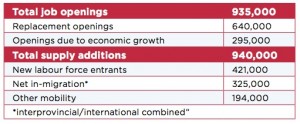The Challenge of Predicting the Future: Supply, Demand and the B.C. Labour Outlook
By Jock Finlayson
The B.C. government recently published new projections for labour demand and supply encompassing the next ten years. Overall, the new labour market outlook is an improvement over earlier efforts. It is based on more rigorous modelling and reflects extensive engagement with employers and other stakeholders in developing the detailed projections.
Problematic Prediction Factors Endure
Even so, a review of the revised forecast underscores the difficult assignment given to the analysts who were charged with completing the work. While it is relatively straightforward to come up with credible projections for labour demand and supply at a macro-level, it is harder to do so for individual industries, occupations and sub-provincial regions.
Business cycles, economic growth rates, commodity markets, the exchange rate, the development and deployment of new technologies, and the competitive dynamics unfolding in various industries: all help to shape the demand for labour—and for particular kinds of skills. These factors cannot be reliably predicted in advance, which complicates the task of forecasting the demand for workers, especially at the industry and occupation level.
Commodity Market Offers Cautionary Tale
For example, consider what has happened to commodity markets. The world-wide upswing in the prices for oil, minerals, metals, and other industrial raw materials that began in 2003 came to a crashing halt after 2012, and then turned into a full-scale rout. The result has been depressed production, investment and hiring activity in the mining and energy sectors over the past two years. The global commodity downturn was not foreseen when the B.C. government released its previous labour market outlook for the 10-year period ending in 2022.
With the recent slump in commodity prices in mind, the latest forecast adopts a more cautious perspective on future job vacancies in the energy, mining and heavy industrial sectors of the provincial economy.
However, commodity markets might rebound more quickly than economists now expect. If so, B.C.’s primary resource and resource-based manufacturing industries would need more new workers than the revised labour market outlook assumes. This is not a criticism of the government’s report. The point is simply to acknowledge the inherent limitations of all attempts to quantify future job vacancies by industry and by occupation.
Demographics Create Further Variance
Forecasting labour supply can also be challenging because of shifts in retirement patterns, interprovincial migration, and the number of international immigrants coming to the province. Over the past four to five years, B.C. has seen average retirement ages creep higher, a decline followed by a more recent jump in net inflows of interprovincial migrants, and a dramatic overhaul of the federal government’s temporary foreign worker (TFW) program that has led to a sharp fall-off in new TFWs entering the province.
We have also watched our neighbour to the east, Alberta, descend into a recession triggered by the collapse of energy prices, which may be setting the stage for a multi-year exodus of skilled workers from that province to other parts of Canada. For employers in B.C., Alberta no longer appears to be such a formidable competitor for talent. Again, these developments were not incorporated into the labour market forecasts published by the B.C. government back in 2012.
Revised B.C. Labour Outlook
The authors of the province’s labour market outlook understand the complexities of forecasting future job openings and the factors that influence labour supply. They consulted widely and used careful economic modelling in coming up with their new projections. The table below provides a high-level summary of the revised B.C. labour demand/supply outlook.
 On the demand side, total new job openings mainly reflect “replacement” positions that will be filled as current workers retire, quit their jobs for other reasons, or die. Approximately one-third of job openings in the next decade arise due to economic growth. The labour demand forecast ignores the potential development of a Liquefied Natural Gas (LNG) industry in British Columbia; because the prospects for LNG remain uncertain, the projections ignore LNG related impacts.
On the demand side, total new job openings mainly reflect “replacement” positions that will be filled as current workers retire, quit their jobs for other reasons, or die. Approximately one-third of job openings in the next decade arise due to economic growth. The labour demand forecast ignores the potential development of a Liquefied Natural Gas (LNG) industry in British Columbia; because the prospects for LNG remain uncertain, the projections ignore LNG related impacts.
Additions to labour supply through 2024 come from three sources: new entrants (those seeking work for the first time, mainly young adults), individuals who migrate to B.C. from elsewhere, and people who change occupations, come back to the workforce or postpone retirement.
Bright Outlook, Tighter Times to Come
The good news is that the outlook points to a balanced labour market in which aggregate demand and supply are in rough alignment for most of the projection period. However, the job market will tighten after 2020, putting upward pressure on wages and salaries. Within this overall picture, talent and more generalized labour shortages are expected to materialize in some industries and occupations. I’ll take a closer look at this part of the story in my next column.
Jock Finlayson is executive vice president and chief policy officer with the Business Council of BC.
(PeopleTalk Winter 2015)






